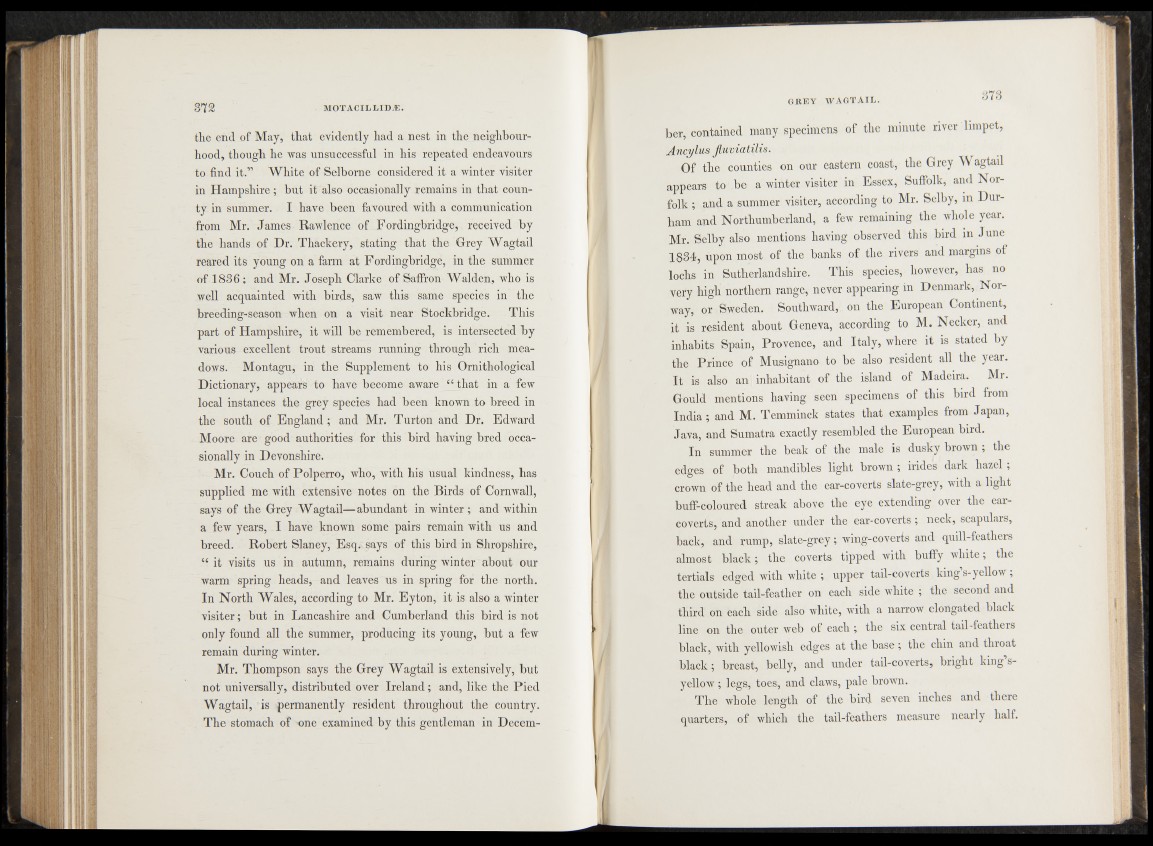
the end of May, that evidently had a nest in the neighbourhood,
though he was unsuccessful in his repeated endeavours
to find it.” White of Selborne considered it a winter visiter
in Hampshire; but it also occasionally remains in that county
in summer. I have been favoured with a communication
from Mr. James Rawlence of Fordingbridge, received by
the hands of Dr. Thackery, stating that the Grey Wagtail
reared its young on a farm at Fordingbridge, in the summer
of 1836; and Mr. Joseph Clarke of Saffron Walden, who is
well acquainted with birds, saw this same species in the
breeding-season when on a visit near Stockbridge. This
part of Hampshire, it will be remembered, is intersected by
various excellent trout streams running through rich meadows.
Montagu, in the Supplement to his Ornithological
Dictionary, appears to have become aware “ that in a few
local instances the grey species had been known to breed in
the south of England; and Mr. Turton and Dr. Edward
Moore are good authorities for this bird having bred occasionally
in Devonshire.
Mr. Couch of Polperro, who, with his usual kindness, has
supplied me with extensive notes on the Birds of Cornwall,
says of the Grey Wagtail—abundant in winter ; and within
a few years, I have known some pairs remain with us and
breed. Robert Slaney, Esq. says of this bird in Shropshire,
,‘f it visits us in autumn, remains during winter about our
warm spring heads, and leaves us in spring for the north.
In North Wales, according to Mr. Eyton, it is also a winter
visiter; but in Lancashire and Cumberland this bird is not
only found all the summer, producing its young, but a few
remain during winter.
Mr. Thompson says the Grey Wagtail is extensively, but
not universally, distributed over Ireland; and, like the Pied
Wagtail, is permanently resident throughout the country.
The stomach of one examined by this gentleman in December,
contained many specimens of the minute river limpet,
Ancylus jtuviatilis.
Of the counties on our eastern coast, the Grey Wagtail
appears to be a winter visiter in Essex, Suffolk, and Norfolk
; and a summer visiter, according to Mr. Selby, in Durham
and Northumberland, a few remaining the whole year.
Mr. Selby also mentions having observed this bird in June
1884, upon most of the banks of the rivers and margins of
lochs in Sutherlandshire. This species, however, has no
very high northern range, never appearing in Denmark, Norway,
or Sweden. Southward, on the European Continent,
it is resident about Geneva, according to M. Necker, and
inhabits Spain, Provence, and Italy, where it is stated by
the Prince of Musignano to be also resident all the year.
It is also an inhabitant of the island of Madeira. Mr.
Gould mentions having seen specimens of this bird from
India ; and M. Temminck states that examples from Japan,
Java, and Sumatra exactly resembled the European bird.
In summer the beak of the male is dusky brown ; the
edges of both mandibles light brown; irides dark hazel;
crown of the head and the ear-coverts slate-grey, with a light
buff-coloured streak above the eye extending over the ear-
coverts, and another under the ear-coverts ; neck, scapulars,
back, and rump, slate-grey; wing-coverts and quill-feathers
almost black; the coverts tipped with buffy white; the
tertials edged with white ; upper tail-coverts king’s-yellow;
the outside tail-feather on each side white ; the second and
third on each side also white, with a narrow elongated black
line on the outer web of each ; the six central tail-feathers
black, with yellowish edges at the base; the chin and throat
black; breast, belly, and under tail-coverts, bright king’s-
yellow ; legs, toes, and claws, pale brown.
The whole length of the bird seven inches and there
quarters, of which the tail-feathers measure nearly half.